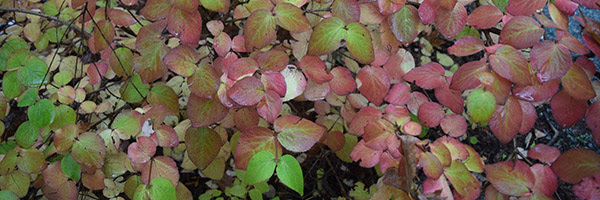Spicy sweet fragrant flowers in spring followed by red berries in summer and flamboyant fall foliage make the Korean spicebush a superlative shrub for Northwest gardens. The species is named for British botanist and diplomat William Richard Carles, who collected this plant during his voyages to Korea in the late 1800s. Carles was one of the first westerners to journey to Korea, and he sent plants he collected from all around Asia to the Royal Botanic Gardens, Kew. William Botting Hemsley, the director of Kew, gave Carles’s name to this especially delicious smelling
Viburnum.
With the changing of the seasons our eyes are keenly drawn to bold transformations and gently fading colors and textures in the garden. My colleagues and I have been renovating the
Viburnum Collections, and so have had the chance to observe and enjoy how these plants change as the weather becomes colder and wetter.
Viburnum carlesii caught my eye for putting on a particularly good fall show. It is vibrant without being ostentatious, with thick pubescent leaves that are currently ranging in shades from green to deep crimson, creating a rather striking effect.

The species is named for British botanist and diplomat William Richard Carles, who collected this plant during his voyages to Korea in the late 1800s. Carles was one of the first westerners to journey to Korea, and he sent plants he collected from all around Asia to the Royal Botanic Gardens, Kew. William Botting Hemsley, the director of Kew, gave Carles’s name to this especially delicious smelling Viburnum. Not only does it look great in the fall, but in spring its pink-tinged buds open to umbels of white, spicy-scented flowers followed by red berries that turn shiny black as summer ends. The common name, Korean spicebush, refers to the plant’s country of origin and fragrant flowers.
Common Name: Korean spicebush, Korean spice viburnum
Family: Adoxaceae
Location: In the Washington Park Arboretum, 4 specimens are located in the Viburnum Collection garden on the east side of the Arboretum Loop Trail. Grids 25-4W and 24-3W.
Origin: Native to Korea and Japan. It is rare in the wild and but can be found growing on hills in calcareous soils.
Height and Spread: Typically grows to 4-7 feet high and wide, though occasionally to over 10 feet tall in shady locations.
Bloom Time: Pink to red-budded flowers open white in 2- to 3-inch-wide, hemispherical cymes in late March-April. Fruits are 1/3-inch-long, flattened and egg-shaped, and mature from red to black in August-September. Fragrant!





No comments:
Post a Comment